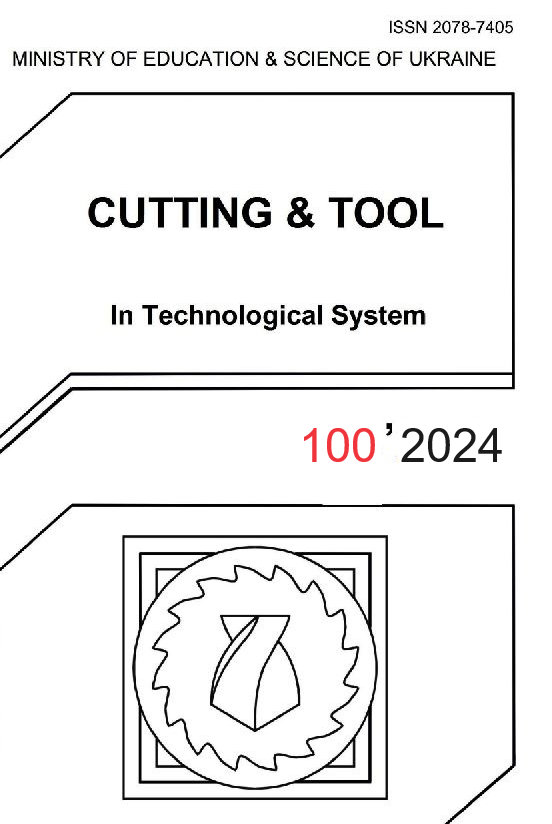DETERMINATION OF THE SIZE OF MEDIUM GRANULES IN FREE ABRASIVE PROCESSING TECHNOLOGY AND THE SIZE OF THE RESERVOIR OF A MACHINE FOR VIBRATION PROCESSING OF PARTS
DOI:
https://doi.org/10.20998/2078-7405.2024.100.14Keywords:
vibration treatment, granular medium, physical and technological parameters, contact angle; reservoir, productivity of vibration processingAbstract
It is noted that the process of vibration processing of parts is carried out by the relative movement and mutual pressure of granules of the medium and the parts being processed circulating in the oscillating reservoir. It is noted that the removal of defects from the surface of a part is carried out by the processes of microcutting and elastoplastic deformation. It is indicated that despite the effectiveness of vibration processing, its capabilities are limited to performing simple operations and have not been sufficiently studied. The effectiveness of vibration processing depends on a number of factors, among which the size of the medium granules and the size of the machine reservoir play a significant role. To determine these factors, the kinematics of the finishing and grinding process was considered, and the joint movement of the medium granule and the part was taken into account. The removal of microchips along the entire length of the machined surface during one period of oscillation of the machine reservoir and the damping properties of the material of the working medium used were also taken into account. It has been established that, depending on the shape of the part, its position and direction of movement in the reservoir, the angle of contact with the granules can vary from 0 to 90º. In this regard, cases of encounters between granules and parts are considered. It has been established that the unfavorable case of a meeting occurs at the right angle of their collision. It is concluded that the removal of microchips from the surface of parts is theoretically inversely proportional to the size of the medium granules. It has been determined that the increase in damping of the medium caused by a decrease in the size of the granules can be compensated by increasing the amplitude of the oscillations of the reservoir and the use of granules with a large specific gravity. The choice of granule size is also limited by the conditions of their access to the surfaces being treated, while the conditions for eliminating the possibility of granules jamming are met. It has been experimentally confirmed that the reservoir with a “U” – shaped cross-section turned out to be the best, due to the absence of stagnant zones in it. It has been established that as the cross-section of the reservoir increases, the productivity of the machine will decrease. Intensifying the process by increasing the amplitude is unacceptable, since this causes the appearance of deep defects on the treated surfaces. To increase processing efficiency, it is necessary to increase the volume of the reservoir by lengthening it, rather than increasing its cross-section.
References
Zhao Q, Sun Z, Guo B. (2016) Material removal mechanism in ultrasonic vibration assisted polishing of micro cylindrical surface on SiC. Int. J. Mach. Tools Manuf. 103:28 39. https://doi.org/10.1016/j.ijmachtools.2016.01. 003
Mitsyk A.V., Fedorovich V.A. Ways of intensification of finishing by combining the schemes of energy effects on the working environment and parts (in Russian). Aerospace engineering and technology. Kharkiv, NAU іm. M.Е. Zhukovs'kogo «KhAІ», 2011. № 6 (83). pp. 26 – 34.
Y. Chen, L. Pan, Zh. Yin, Y. Wu. Effects of ultrasonic vibration-assisted machining methods on the surface polishing of silicon carbide, Volume 59, pages 7700–7715, 2024 https://doi.org/10. 1007/s10853-024-09661-x
Li, L., Kao, I., Experimental study of the impact of a vibrating wire on free abrasive machining as correlated to the modeling of vibration subject to an oscillating boundary condition. Journal of Manufacturing Science and Engineering, Transactions of the ASME, 143(5), 051006, 2021 https://doi.org/10.1115/1.4048637
Bhagavat, S., Liberato, J.C., Chung, C., Kao, І. Effects of mixed abrasive grits in slurries on free abrasive machining (FAM) processes. International Journal of Machine Tools and Manufacture , 50(9), pp. 843‒847, 2010 https://doi.org/10.1016/j. ijmachtools.2010.04.006
Tools for machining parts with free abrasives (in Ukrainian): monografіja / M.O. Kalmykov, T.O. Shumakova, V.B. Strutins'kij, L.M. Lubens'ka. Kyiv – Luhans'k: «Noulіdzh», 2010. 214 p.
Mitsyk А.V., Fedorovich V.A., Ostroverkh Y.V. Purpose and technological properties of granular media for vibration finishing and grinding processing. Cutting & Tools in Technological System. Kharkiv, NTU «KhPІ». 2023. № 99. pp. 85 – 93. https://doi:10.20998/2078-7405.2023.99.10
Opirskij B. Ja., Denisov P.D. New vibrating machines (in Ukrainian). L'viv: Svit, 1991. 160 p.
Mitsyk A.V., Fadeev V.A., Fedorovich V.A. Development of the issues of kinematics and dynamics of finishing processes in an oscillating tank (in Russian). Cutting & Tools in Technological System. Kharkiv, NTU «KhPІ», 2012. № 82. pp. 171 – 182.
Downloads
Published
Issue
Section
License
Copyright Notice
Authors who publish with this Collection agree to the following terms:
1. Authors retain copyright and grant the Collection right of first publication with the work simultaneously licensed under a Creative Commons Attribution License that allows others to share the work with an acknowledgement of the work's authorship and initial publication in this Collection.
2. Authors are able to enter into separate, additional contractual arrangements for the non-exclusive distribution of the Collection's published version of the work (e.g., post it to an institutional repository or publish it in a book), with an acknowledgement of its initial publication in this Collection.
3. Authors are permitted and encouraged to post their work online (e.g., in institutional repositories or on their website) prior to and during the submission process, as it can lead to productive exchanges, as well as earlier and greater citation of published work.

